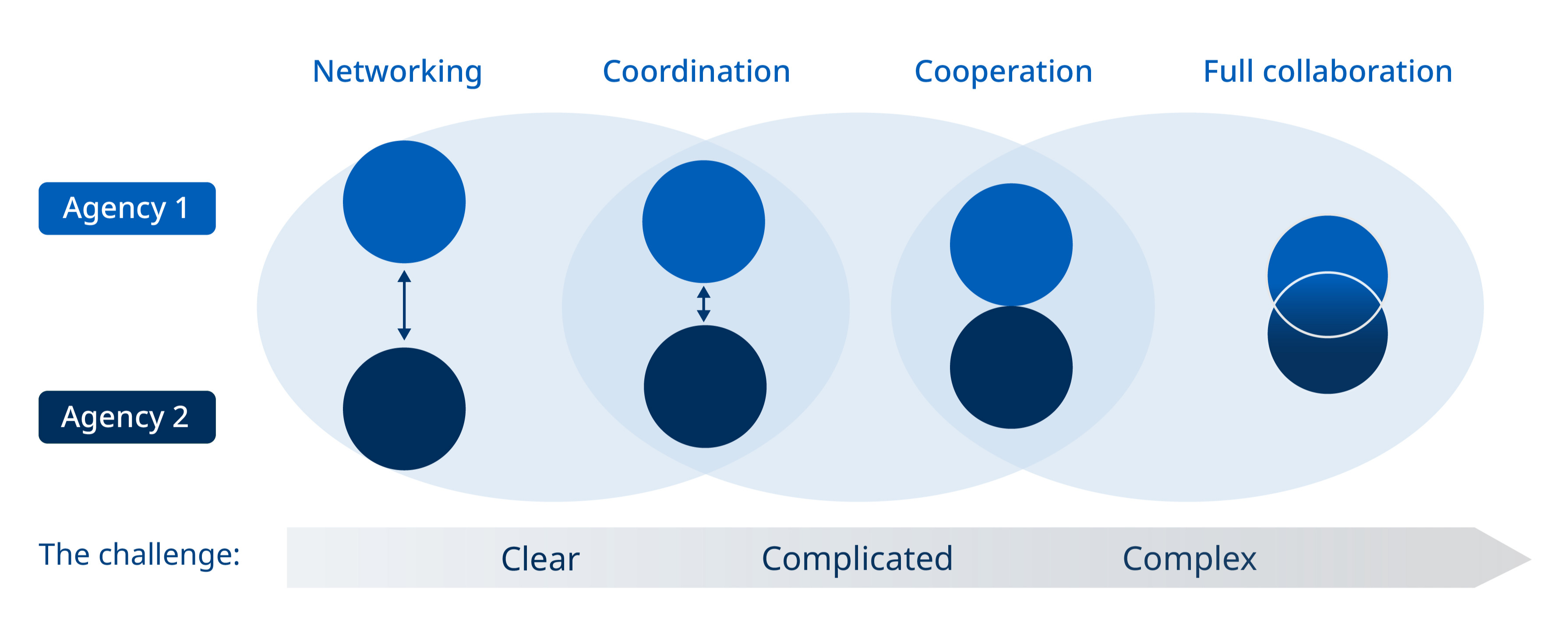Levels of collaboration
Cross-agency collaboration takes many forms. It can be as simple as agencies sharing information informally. It can be as complex as agencies partnering on delivering a project. No single approach is better than the other. If you over-collaborate, you risk spending too much time and resources without clear benefits. If you under-collaborate, you may miss opportunities to tackle complex issues that need joint efforts.
It can be hard to reach the best level of collaboration that the scope of your project needs. Systemic barriers (such as inability to share budgets or siloed legacy IT systems) can stop us from operating at the optimal level. Building the capability to collaborate effectively, will help you maintain momentum despite these barriers.
Understand the different levels of collaboration and find the approach best suited to the complexity of your work.
Networking is the most informal level of collaboration. It’s about building relationships, sharing information and staying informed about developments across other agencies. Networking lets us:
- share best practices
- exchange valuable insights
- identify shared goals between stakeholders.
Networking helps to ensure a more cohesive and informed approach to problem-solving.
When to use networking
Networking is ideal when your main goals are to raise awareness and build relationships. It’s the best approach to keep agencies informed and create connections that could lead to deeper levels of collaboration down the track.
Key activities
- Sharing updates and information
- Building professional relationships
- Joining forums, working groups, or communities of practice
Examples of networking
- Inviting people from other agencies to your internal briefings
- Attending networking events, like those run by the Institute of Public Administration Australia (IPAA Qld)
- Sharing lessons learned from completed projects in Communities of Practice
- Participating in collaborative research projects without formal agreements
- Connecting with others at training sessions or networking events
- Casual conversations in shared spaces, like lobbies or during breaks
Networking helps you lay the groundwork for stronger partnerships and future collaboration while staying informed and connected.
Find resources to help you network and to connect with other collaborators, visit GovNet.
Coordination is about agencies working together to align their efforts while still maintaining their own responsibilities and resources. It ensures activities complement each other without requiring shared decision-making or pooled resources. This collaboration approach helps streamline efforts, reduce overlaps and ensure that all stakeholders are working towards shared goals in an efficient way.
When to use coordination
Use coordination when agencies need to align activities to ensure consistency and avoid duplication. It’s the best approach when there’s no need to share decisions or resources, but clear communication is required to stay aligned.
Key activities
- Aligning timelines to work smoothly together
- Ensuring messaging is consistent and supports a shared purpose
- Clarifying roles and responsibilities between agencies
- Consulting with others to avoid overlapping or duplicating efforts
Examples of coordination
- Two departments align their public messaging on a shared policy to avoid confusion.
- Agencies coordinate public consultations to prevent overwhelming stakeholders.
- Departments agree on shared reporting metrics for related programs.
- Agencies synchronise event calendars to avoid scheduling conflicts.
- Departments align grant funding cycles to make the best use of resources.
Cooperation involves agencies working together in a more focused way towards shared goals. You can do this through joint planning, sharing some resources and combining efforts to work more effectively and efficiently together.
When to use cooperating
Cooperating is most suitable when agencies have similar goals and need to work together to achieve better results. Use it to tackle complicated challenges, such as implementing large-scale infrastructure projects. It is less suited to highly complex issues that a need deeper level collaboration.
Key activities
- Joint planning and problem-solving
- Sharing resources like funding, staff, or data
- Making shared decisions on specific tasks or activities
Examples of cooperation
- Agencies create a shared training program to improve frontline services.
- Departments develop consistent community engagement guidelines together.
- Government agencies collaborate on a cross-sector data-sharing initiative to improve service delivery.
- Agencies co-host public webinars on a common policy issue.
- A multi-department working group drafts a joint response to an emerging challenge.
Full collaboration is the most involved form of working together. Agencies work closely together, sharing resources, decision-making and accountability to achieve a common goal.
When to use full collaboration
Use full collaboration when a complex challenge requires sustained, high-level commitment across agencies. This will help you achieve meaningful, long-term outcomes.
Key activities
- Sharing resources like funding, staff and tools
- Making joint decisions and sharing accountability
- Integrating systems, processes, or service delivery
Examples of full collaboration
- A multi-agency taskforce is formed to address a complex social issue, sharing governance, funding and service delivery.
- Agencies create a joint response unit to manage disaster recovery efforts.
- Government agencies partner to develop a shared digital platform for accessing public services.
- A multi-agency workforce development program is created to address sector-wide skills shortages.
- Agencies co-design and deliver a long-term public health strategy with integrated service delivery.
Even when there is one level of collaboration best suited to your challenge, there may be aspects of your work that suit a different level of collaboration.
Read the Cross-agency collaboration activities to learn what happens at each level of collaboration.
Find the level of collaboration that best suits your project.